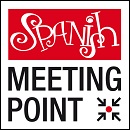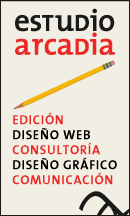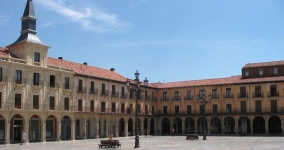Spanish schools and accommodation to study Spanish in Spain
Recent posts
Last schools
introduced
introduced
0 Accommodation

2 Spanish schools

Learning Spanish in Leon. The tourist guide to study your Spanish course.
General Information. 135,000 inhabitants, and more than 200,000 in the metropolitan area. 330 kilometres to the north of Madrid. Leon belongs to the Autonomous Community of Castile and Leon. Situated at the confluence of the Torio and Bernesga Rivers, Leon has its origin in a Roman military camp established in 29 BC. It boasts a rich architectural and artistic heritage, and important archaeological remains in the surrounding province. It is also one of the northern Spanish cities on the Camino de Santiago, the famous pilgrimage route to Santiago de Compostela. The city is home to the University of Leon, which caters for some 15,000 students, and it also has a site of the University of Washington, with capacity for 500 students. Leon is a very attractive place to study Spanish with many language schools offering a wide range of courses.
Surrounding Areas. The Church of St. Michael (Iglesia de San Miguel, 30 kilometres), built on the remains of a Visigothic church and considered the most beautiful Mozarabic temple in the province of Leon. Valencia de Don Juan (40 kilometres), with its recently reconstructed 12th century castle. Astorga (50 kilometres), a historic town with a fine collection of monuments. Sahagún (70 kilometres), with several Mudejar churches and a rich architectural heritage. Oviedo (110 kilometres). Parque Nacional Picos de Europa, a National Park in the Picos de Europa mountain range (130 kilometres). Las Médulas (140 kilometres); this spectacular landscape in the El Bierzo region, formed by the remains of a Roman alluvial gold mine, was declared a UNESCO World Heritage Site in 1997.
Main Sights. Leon possesses several Sites of Cultural Interest, including: the Gothic-style Cathedral, which began to be constructed in the 13th century on the site of an old Romanesque cathedral; the Basilica of St. Isidore, one of the most important examples of Romanesque art that exists in Spain; the Monastery of St. Mark, and Antonio Gaudí's neo-Gothic Casa Botines. Other monuments are the Palacio de los Guzmanes, a 16th century palace which now serves as the headquarters of the Provincial Council, Palacio del Conde Luna, a 14th century palace and formerly the seat of the Kingdom of Leon, and Plaza Mayor, the city's main square. There are numerous parks and gardens, such as Parque de Chantre, Parque de Quevedo, Parque de La Granja, Jardín del Cid and Jardín de San Francisco. The monuments are a major attraction for the many students who decide to study Spanish in Leon.
Culture. Leon has various museums: a contemporary art museum called MUSAC (Museo de Arte Contemporáneo de Castilla y León), which opened in 2005; the Leon Museum, the oldest in the province; the Museum of the Royal Collegiate Church of St. Isidore (Museo de la Real Colegiata de San Isidro); the Cathedral and Diocesan Museum of Leon (Museo Catedralicio Diocesano de León); and the Biblical and Oriental Museum (Museo Bíblico y Oriental). There are two theatres: Teatro Emperador, open to the public since 1951, and Teatro Trianón. Leon also has a bullring known as Leon Arena, built in 1948.
Shopping. Besides the shopping area in the city centre, where you can find all the leading brand names, a less commercial option is the Rastro Dominical, a flea market that opens on Sundays on Avenida de Papalaguinda, with stalls selling clothes, footwear, music, antiques... at bargain prices. Espacio León is the biggest shopping centre in Leon, with fashion stores, restaurants and various facilities and services for customers.
Gastronomy. The best option for trying the local tapas and wines is Barrio Húmedo, the neighbourhood with the highest concentration of bars and taverns in the city. Leon boasts a wealth of local produce, particularly beef and young lamb from the Teleno mountains, traditionally made sausages such as cecina (dry-cured beef) and morcilla (the Spanish equivalent of black pudding), not to mention all kinds of vegetables, several cheeses and a number of good wines. The typical dishes in Leon are the emblematic botillo de El Bierzo (a smoked and semi-cured pork intestine stuffed with minced pork rib and tail marinated in salt, paprika and garlic), cocido maragato (in this region, the main ingredients of this traditional Spanish stew are served in the following order: vegetables, chick peas, pork cuts and, finally, the noodle broth), callos a la leonesa (stewed tripe), ternera (veal) and lechazo (young lamb). The most traditional items of confectionery are the famous mantecados de Astorga (rich, crumbly ‘lardy cakes' containing ground almonds), lazos de San Guillermo (bow-shaped pastries) and bizcochos de San Lorenzo (sponge cakes). Other typical desserts include frisuelos (pancakes), arroz con leche (rice pudding) and leche frita (fried custard squares).
Sports. Leon has two basketball teams, Baloncesto León S.A.D. (men) and Club Baloncesto San José (women). In Leon you can play or learn almost any sport. Facilities include two stadiums (Estadio Reino de León and Estadio Hispánico), several sports centres, such as La Palomera, a sports hall (Pabellón La Torre), an indoor sports arena (Palacio de Deportes), an outdoor equestrian sports complex (Campo Hípico "El Parque"), and the Area Deportiva de Puente Castro, which includes a hockey pitch, a rugby pitch and a training ground. There are two golf courses near Leon.
Fiestas. Holy Week, which has been declared an Event of International Tourist Interest, is particularly important in Leon, as is the annual Carnival (February). As for specifically local fiestas, it is worth highlighting Las Cabezadas (end of April) and the Romería a la Virgen del Camino (5th October), a popular 12-kilometre pilgrimage from the Cathedral to the Shrine of the Virgin outside Leon.
Transport. A tourist train, which departs from Plaza San Marcelo, provides a tour of the main sights of interest during the summer months. It is easy to get from Leon to other Spanish cities by train or by using the various coach services.
Nightlife. Students who decide to study Spanish in Leon will discover a very active nightlife. There are two traditional starting points for a night out in Leon: Barrio Húmedo and Barrio Románico, where there are numerous pubs and plenty of wine and tapas bars to choose from. Once these places close, the partying continues in the discotheques on Calle Lancia.
Surrounding Areas. The Church of St. Michael (Iglesia de San Miguel, 30 kilometres), built on the remains of a Visigothic church and considered the most beautiful Mozarabic temple in the province of Leon. Valencia de Don Juan (40 kilometres), with its recently reconstructed 12th century castle. Astorga (50 kilometres), a historic town with a fine collection of monuments. Sahagún (70 kilometres), with several Mudejar churches and a rich architectural heritage. Oviedo (110 kilometres). Parque Nacional Picos de Europa, a National Park in the Picos de Europa mountain range (130 kilometres). Las Médulas (140 kilometres); this spectacular landscape in the El Bierzo region, formed by the remains of a Roman alluvial gold mine, was declared a UNESCO World Heritage Site in 1997.
Main Sights. Leon possesses several Sites of Cultural Interest, including: the Gothic-style Cathedral, which began to be constructed in the 13th century on the site of an old Romanesque cathedral; the Basilica of St. Isidore, one of the most important examples of Romanesque art that exists in Spain; the Monastery of St. Mark, and Antonio Gaudí's neo-Gothic Casa Botines. Other monuments are the Palacio de los Guzmanes, a 16th century palace which now serves as the headquarters of the Provincial Council, Palacio del Conde Luna, a 14th century palace and formerly the seat of the Kingdom of Leon, and Plaza Mayor, the city's main square. There are numerous parks and gardens, such as Parque de Chantre, Parque de Quevedo, Parque de La Granja, Jardín del Cid and Jardín de San Francisco. The monuments are a major attraction for the many students who decide to study Spanish in Leon.
Culture. Leon has various museums: a contemporary art museum called MUSAC (Museo de Arte Contemporáneo de Castilla y León), which opened in 2005; the Leon Museum, the oldest in the province; the Museum of the Royal Collegiate Church of St. Isidore (Museo de la Real Colegiata de San Isidro); the Cathedral and Diocesan Museum of Leon (Museo Catedralicio Diocesano de León); and the Biblical and Oriental Museum (Museo Bíblico y Oriental). There are two theatres: Teatro Emperador, open to the public since 1951, and Teatro Trianón. Leon also has a bullring known as Leon Arena, built in 1948.
Shopping. Besides the shopping area in the city centre, where you can find all the leading brand names, a less commercial option is the Rastro Dominical, a flea market that opens on Sundays on Avenida de Papalaguinda, with stalls selling clothes, footwear, music, antiques... at bargain prices. Espacio León is the biggest shopping centre in Leon, with fashion stores, restaurants and various facilities and services for customers.
Gastronomy. The best option for trying the local tapas and wines is Barrio Húmedo, the neighbourhood with the highest concentration of bars and taverns in the city. Leon boasts a wealth of local produce, particularly beef and young lamb from the Teleno mountains, traditionally made sausages such as cecina (dry-cured beef) and morcilla (the Spanish equivalent of black pudding), not to mention all kinds of vegetables, several cheeses and a number of good wines. The typical dishes in Leon are the emblematic botillo de El Bierzo (a smoked and semi-cured pork intestine stuffed with minced pork rib and tail marinated in salt, paprika and garlic), cocido maragato (in this region, the main ingredients of this traditional Spanish stew are served in the following order: vegetables, chick peas, pork cuts and, finally, the noodle broth), callos a la leonesa (stewed tripe), ternera (veal) and lechazo (young lamb). The most traditional items of confectionery are the famous mantecados de Astorga (rich, crumbly ‘lardy cakes' containing ground almonds), lazos de San Guillermo (bow-shaped pastries) and bizcochos de San Lorenzo (sponge cakes). Other typical desserts include frisuelos (pancakes), arroz con leche (rice pudding) and leche frita (fried custard squares).
Sports. Leon has two basketball teams, Baloncesto León S.A.D. (men) and Club Baloncesto San José (women). In Leon you can play or learn almost any sport. Facilities include two stadiums (Estadio Reino de León and Estadio Hispánico), several sports centres, such as La Palomera, a sports hall (Pabellón La Torre), an indoor sports arena (Palacio de Deportes), an outdoor equestrian sports complex (Campo Hípico "El Parque"), and the Area Deportiva de Puente Castro, which includes a hockey pitch, a rugby pitch and a training ground. There are two golf courses near Leon.
Fiestas. Holy Week, which has been declared an Event of International Tourist Interest, is particularly important in Leon, as is the annual Carnival (February). As for specifically local fiestas, it is worth highlighting Las Cabezadas (end of April) and the Romería a la Virgen del Camino (5th October), a popular 12-kilometre pilgrimage from the Cathedral to the Shrine of the Virgin outside Leon.
Transport. A tourist train, which departs from Plaza San Marcelo, provides a tour of the main sights of interest during the summer months. It is easy to get from Leon to other Spanish cities by train or by using the various coach services.
Nightlife. Students who decide to study Spanish in Leon will discover a very active nightlife. There are two traditional starting points for a night out in Leon: Barrio Húmedo and Barrio Románico, where there are numerous pubs and plenty of wine and tapas bars to choose from. Once these places close, the partying continues in the discotheques on Calle Lancia.
© TEXT: SPANISH IN TOUR.























